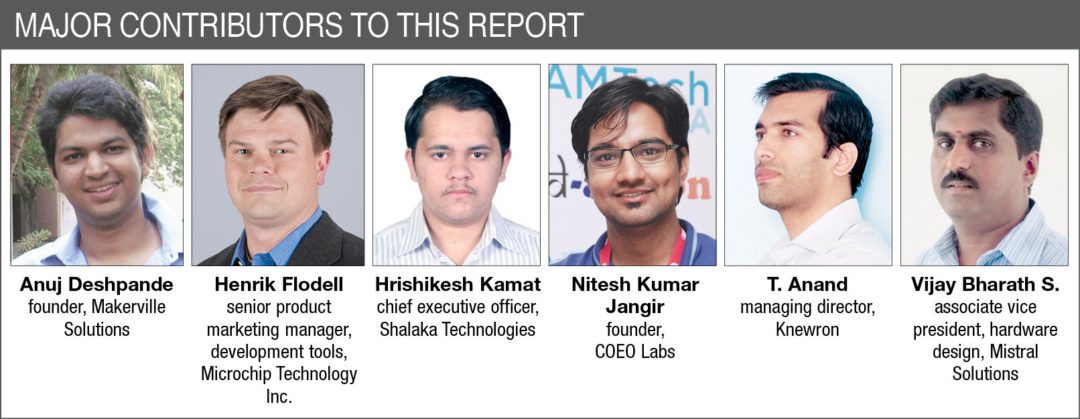A look at some development boards
“With reference boards the motive is to provide support for maximum solutions. Intensive programs might not work due to either software development kit not being up to the challenge or memories being insufficient,” says Bharath. Deshpande adds, “In a general-purpose board, many controls are automatic, which is not the case with a focused solution.”
Development boards are available for a very wide range of applications ranging from music processing to agriculture. Suppose, we require a solution for wireless connectivity without power consumption of Wi-Fi, we have Pinoccio board to get the job done. “This simplifies a lot of things and allows working with the device aesthetics as well,” adds Anand.
As per Flodell, “Certification of equipment according to numerous international standards directives is very important.”
Wireless connectivity focus
Crowd-funded Pinoccio development board has Atmel ATmega256RFR2 at its core. Pinoccio is a wireless, Web-ready microcontroller board packed with Wi-Fi, lithium-polymer battery and built-in radio. Each unit can communicate with one another using a mesh network for easy connectivity.
SmartWiFi module from Knewron is another example of a wireless-focused board currently available. Connectivity is being prioritised in product development today and such solutions come in handy. Winkel board offers another alternative by offering WiFi, Bluetooth, 2.4GHz ISM and an RTC on the same board. It’s compatible with Arduino and is usable without different shields for different tasks.
Connectivity solutions are also available through various other boards. However, incorporation of a multitude of other peripherals makes these suitable for do-it-yourself and not so much for product development.
Incorporating Wi-Fi into a solution requires going for a custom board, which brings in several other factors. “Small form factor and ease of integration have been crucial factors with SmartWiFi,” says Anand.
A wireless Arduino with a 0.8km (half-mile) range would be an interesting addition to these solutions. Flutter lets users develop mesh networking protocols and connect various devices. Wireless applications can range from robotics, consumer electronics and wireless sensor networks to educational platforms. Flutter is packed with Atmel SMART SAM3S Cortex-M3 processor, while for security it has ATSHA204 crypto engine.

Connectivity in small size: wearable/IoT
Development boards for the IoT and wearables have undergone the most refinement. Today these are so highly optimised, you can prototype on a board. And if you find any feature unsuitable for your applications, you would find another that meets all your specifications, hence, reducing bills of material and time to market. So the area that requires developers’ attention the most is efficient software-hardware integration.
Extensive use of sensors has also been a boon for IoT applications. Apart from being used in custom projects, now miniature sensors are being used for almost everything. Metaware boards from Mbientlabs are one such example.
Popularisation of the IoT and wearables has lead to huge adoption of wearables and, in turn, demand for development boards that suit the applications. With sensors like activity detection, temperature measurement, compass and gravity, among others, these come in quite a small package, for easy applicability in healthcare, fitness, commercial and industrial wearables.
To develop wearables and connected IoT nodes, Thunderboard Wear is a possible solution. The demo board is based on ARM mbed wearable reference design and features Silicon Labs’ EFM32 Giant Gecko along with Bluetooth Smart connectivity. It includes an onboard USB programmer and debugger, and has external connections for real-time energy profiling through Simplicity Studio.
UDOO is another platform solution for Android, Linux, Arduino and Google accessory development kit 2012. Built upon ARM Cortex-A9 CPU and Atmel SMART SAM3X8E ARM Cortex-M3 CPU, it provides a flexible environment that allows you to work with the IoT development. Replacing the microSD card and rebooting the system allows switching between Linux and Android.
Connectivity is being prioritised and we will always have multiple products to take care of it. Let us take a look at some solutions suitable for other applications as well.
Help in healing
Equipment design for medical purposes is an extremely sensitive matter and, hence, we do not see many pre-built solutions in this field. The field requires very high precision and safety; even slight miscalculation can lead to very disastrous results. However, there are solutions available for the prototyping stage. Jangir explains the types of requirements from the equipment design perspective. “Wearables, therapeutic equipment and diagnostics can be the broad categorisation of the type of equipment designed,” he says.
“We use development boards during prototyping for verification of our programs on a microcontroller,” adds Jangir. However, current boards are not as efficient for medical device designing. The reason being “requirement of high-performance analogue-to-digital converter and digital-to-analogue converter for operating on physical signals received from the patient,” he explains.
BITalino is an example of biomedical data-acquisition development board for the creation of projects using physiological sensors and tools. The board consists of Bluetooth, power, electromyography block, electrodermal activity block, electrocardiogram block, accelerometer, light emitting diode and light sensor. Powered by ATMega328 microcontroller, it can be configured with a sampling rate up to 1GHz and is capable of supporting six analogue inputs (four at 10-bit, two at 6-bit), four digital inputs and four digital outputs.











I totally agree that development boards have become extremely useful for designers. more and more developers working with ARM single board computer to design their new products or apply it in their new projects. development board is widely used in more and more applications such as HMI, robotic, medical, industrial control, IoT, electronics, smart home, portable devices, automatics, intelligent traffic and many other industries. and there are more and more excellent ARM development board suppliers in China, such as Forlinx Embedded, MYIR, Qiyang, etc.
Which board should I use for video capturing and directly display . I dont need to save the video nor do I need audio.Please suggest.A 2 MP camera would be more than enough .